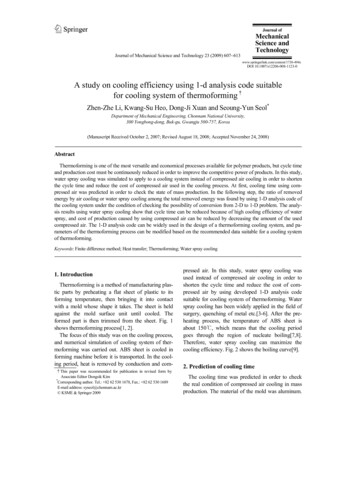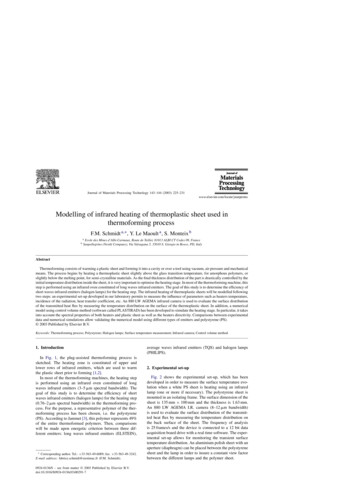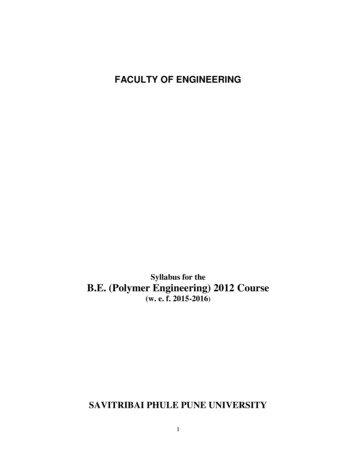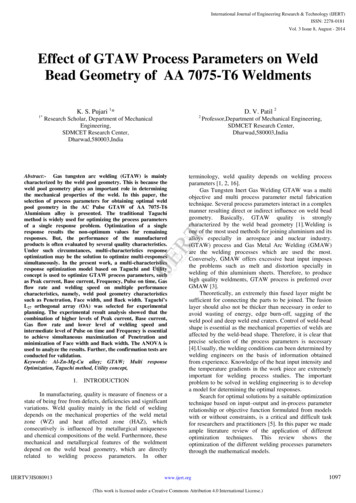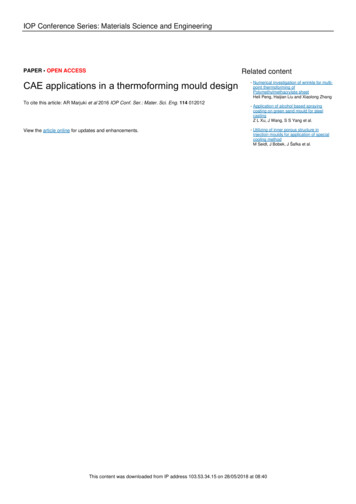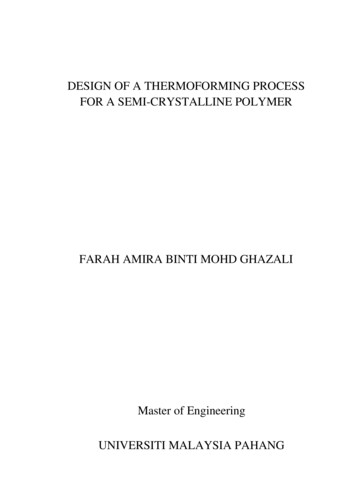
Transcription
DESIGN OF A THERMOFORMING PROCESSFOR A SEMI-CRYSTALLINE POLYMERFARAH AMIRA BINTI MOHD GHAZALIMaster of EngineeringUNIVERSITI MALAYSIA PAHANG
SUPERVISOR’S DECLARATIONI hereby declare that I have checked this thesis and in my opinion, this thesis is adequatein terms of scope and quality for the award of the degree of Master of Engineering inManufacturing.(Supervisor’s Signature)Full Name:Position:Date:
STUDENT’S DECLARATIONI hereby declare that the work in this thesis is based on my original work except forquotations and citations which have been duly acknowledged. I also declare that it hasnot been previously or concurrently submitted for any other degree at Universiti MalaysiaPahang or any other institutions.(Student’s Signature)Full Name: FARAH AMIRA BINTI MOHD GHAZALIID Number: MMF13005Date: 18/8/2017
DESIGN OF A THERMOFORMING PROCESS FOR ASEMI-CRYSTALLINE POLYMERFARAH AMIRA BINTI MOHD GHAZALIThesis submitted in fulfillment of the requirementsfor the award of the degree ofMaster of EngineeringFaculty of Manufacturing EngineeringUNIVERSITI MALAYSIA PAHANGAUGUST 2017
ACKNOWLEDGEMENTSI would love to condone my utmost appreciation towards my loving parents foralways having faith in me in accomplishing my master’s degree. Their love and supportduring my study has constantly been my greatest motivation for me to complete thisthesis.Countless credits to my honourable supervisor, Assoc. Prof. Dr. Abdul Aziz binJaafar for his supreme guidance. It has been an astounding journey in the world ofresearch in which I have learnt many things and achieved great things with Allah’s will.His continuously great effort has inspired me to conduct my research and to that I offerhim my modest appreciation.Similarly, profound gratitude goes to the many technical staff members of thefaculty of Manufacturing Engineering, especially to Mr. Shahanzir, Mr. Aidil Shafiza,Mr. Yahya, who have been truly dedicated mentors. Not to mention my fellowcolleagues from the iMaM and Al-Jazari laboratory who helped me a lot in my work. Iowe them a lot for their assistance in my machining work in the Milling Laboratory.I am also hugely appreciative to Dr. Noor Mazni Ismail, especially for sharingher expertise in material polymer so willingly, and for being so dedicated to her role asmy secondary supervisor. Special mention goes to my colleagues, Nur Iffah, Norlida,Aisyah, Aini, Siti Nur Sakinah, Hafiz, Rashid and Faiz, Zaimah and Nik for going farbeyond the call of duty in helping me out in my research. This accomplishment wouldnot have been possible without them. In addition to that, I would like to extend mythanks to the many people, in many countries, who so generously contributed to thework presented in this thesis.Thank youii
TABLE OF CONTENTDECLARATIONTITLE PAGEACKNOWLEDGEMENTSiiABSTRAKiiiABSTRACTivTABLE OF CONTENTvLIST OF TABLESxLIST OF FIGURESxiCHAPTER 1 INTRODUCTION11.1Introduction11.2Problem Statement41.3Objectives of Research41.4Scope of Study51.5Overview of Thesis5CHAPTER 2 LITERATURE REVIEW62.1Introduction62.2Thermoforming Process62.2.1Vacuum Forming82.2.2Drape Forming Technique2.312Thermoforming Equipment132.3.115Ovenv
2.42.52.62.3.2Platen162.3.3Clamping Frame162.3.4Vacuum Systems17Thermoforming Moulds172.4.1Mould Materials192.4.2Venting Systems in Moulds20Part Design202.5.1Design Protocol222.5.2Design Characteristics222.5.3General Product Design232.5.4Draft Angles252.5.5Draw Ratio262.5.6Moldability272.5.7Guidelines for Successful Part Design292.5.8Computational Simulation of Thermoforming30Thermoplastic Material used in Thermoforming Process312.6.1Fourier Transform Infrared Spectroscopy (FTIR)322.6.2Differential Scanning Calorimetry (DSC)322.7Polypropylene322.8Material Distribution of Thermoformed Part332.8.1Stretching Behaviour of Thermoplastic Sheet on Positive Mould352.8.2Parameters Affecting the Material Distribution of ThermoformedPart362.9Grid Marking362.10Summary of Chapter 238vi
CHAPTER 3 METHODOLOGY393.1Introduction393.2Process flow of activities in study393.3Mould Design423.4Mould Fabrication443.4.146Machining Process3.5Thermoforming Equipment473.6Polypropylene Polymer Material543.7Material Characterisation543.7.1Differential Scanning Calorimetry (DSC) of Polymer Sample553.7.2Fourier Transform Infrared Spectroscopy of Polymer Sample553.83.93.103.113.12Pre-Thermoforming Process of Polypropylene Polymer Sheet563.8.1Temperature Assessment573.8.2Preparations Prior to Thermoforming Process60Thermoforming Process of Polypropylene Part603.9.163Behaviour of Thermoplastic Sheet during HeatingComputing Thermoforming Using ANSYS Polyflow653.10.1 Preparations and Blank Material Behaviour673.10.2 POLYDATA69Simulation of Thermoforming Process of 1.5mm Polymer Sheet713.11.1 Simulation of Thermoforming Process using Adaptive Meshing74Summary of Chapter 374CHAPTER 4 RESULTS AND DISCUSSION754.175Introductionvii
4.2CAD of Mould754.3Design of Positive Mould764.4Material Characterisation764.4.1Differential Scanning Calorimetry (DSC) Test Results764.4.2Fourier Transform Infrared Spectroscopy (FTIR) Test Results774.5Temperature Assessment of Heating Stage for a Thermoforming Equipment 794.6Thermoforming Process of Polypropylene Polymer814.6.1Thermoplastic Behaviour during Heating Phase814.6.2Stretch Marks on Thermoformed Part814.6.3Part Removal from Positive Mould854.7Simulation of Thermoforming Process of Polypropylene Polymer4.7.186Simulation of Thermoplastic Sheet with Velocity of 50mm/s and100 mm/s864.7.2Simulation of Thermoplastic Sheet using Adaptive Meshing884.7.3Simulation of Thermoforming Process with 1.5mm Thickness ofThermoplastic Sheet904.8Calculations of Final Thickness of Thermoformed Part934.9Summary of Chapter 495CHAPTER 5 CONCLUSIONS AND DISCUSSIONS965.1Introduction965.2Summary of Research965.3Discussion and Implications of Findings985.4Limitations of Research995.5Recommendations for future work99REFERENCES102viii
APPENDIX A107APPENDIX B112APPENDIX C113APPENDIX D114APPENDIX E116ix
LIST OF TABLESTable 2.1The Process Flow of Vacuum Forming10Table 2.2Tooling Conductivity Data20Table 2.3General guidelines in Mould Design30Table 3.1Features of mould43Table 3.2Boundary condition of Turning Process for Truncated ShapePositive Mould44Boundary condition of Turning Process for Truncated ShapePositive Mould45Properties between a mould with a venting system and without aventing system47Table 3.5Components of Thermoforming Equipment49Table 3.6Properties of grid stamp60Table 3.7Test Rig Properties in Thermoforming Process of Polypropylene62Table 3.8Condition and properties of Domain70Table 3.9Numerical Parameters and Boundary Conditions for Polydata forVelocity of 100 mm/s71Table 3.10Translation velocity of mould71Table 3.11Translation velocity of mould with Z-direction 1000mm/s71Table 3.12Conditions and properties during simulation of 1.5mm PolymerSheet72Table 4.1Properties of Polypropylene Polymer Sample77Table 4.2Solutions in webbings of thermoformed part84Table 4.3Typical Shrinkage Range for Several Polymer Materials inThermoforming85Specifications during simulation of thermoforming of 1.5mmthickness blank material91Percentage of thinning on the areas of the thermoformed part94Table 3.3Table 3.4Table 4.4Table 4.5x
LIST OF FIGURESFigure 1.1Word production of plastic materials2Figure 1.2Bar chart of varieties of uses of plastics in 20143Figure 2.1Thermoplastic products manufactured by thermoforming process.8Figure 2.2A schematic process diagram of Drape Forming Technique13Figure 2.3A schematic diagram of the thermoforming equipment15Figure 2.4Pictorial of an adjustable clamping frame used in high endthermoforming equipment17Figure 2.5Basic structural design of male and female mould18Figure 2.6Schematic diagram of truncated shape positive mould23Figure 2.7Schematic of basic plug-assisted thermoforming process25Figure 2.8Schematic diagram of draw ratio features for a male(positive) andfemale (negative) mould.27Figure 2.9Shows another example of a part design of (a) undrafted and (b)drafted part. For negative moulds, guidelines from thermoformingindustries suggest that draft angles are presented as one of the partdesign of the mould to provide a smoother production. The releasingof the thermoformed part from the mould with presented draft anglealso prevents from any ruptures.28Figure 2.10Diagram of an undrafted and drafted part29Figure 2.11A schematic diagram of male or positive and female or negativeforming.34Schematic diagram showing one-half of the truncated positivemould during forming in vacuum forming process35Figure 2.13Gridline plastic sheet stretched onto positive mould37Figure 2.14HIPS thermoformed parts with grid markings on positive mould at(a) 130oC and (b) 140oC. HIPS: High Impact Polystyrene38Figure 3.1Process flow of main activities in the study41Figure 3.2Schematics of positive mould with venting system43Figure 3.3Mould A during turning process45Figure 3.4Turning process of mould B fabrication46Figure 3.5Fabricated mould without venting system.46Figure 3.6Fabricated mould with venting system47Figure 3.7(a) Initial CAD design of thermoforming equipment (b) Pictorialimage of thermoforming equipment48Figure 2.12xi
Design of thermoforming process – step 1 and step 2 inthermoforming process.50Figure 3.9Oven section of thermoforming equipment51Figure 3.10Pictorial of (a) Vacuum section of the specific built thermoformingequipment and (b) Installation of flexible hose and piping fixture tothe platen52Figure 3.11Analogue vacuum pressure gauge from RS Component Sdn Bhd(product model type : SMC GZ46-K-01)53Pictorial of (a) Clamping frame of thermoforming equipment and(b) Positioning the clamping frame during the heating stage53Figure 3.13Schematic of Different Scanning Calorimetry Process Flow55Figure 3.14Testing the polymer (a) sample A and (b) sample B by means ofFTIR method56Figure 3.8Figure 3.12Figure 3.15Schematics and physical arrangement of thermocouples for full- andquarter-configurations experimental setup. (a) Natural convection ofair through the orifices during the heating stage (b) plan view and apictorial image of the quadrant- configuration setup forthermocouple arrangements and (c) thermocouples allocated on onequadrant of the mesh.58Figure 3.16Physical and monitoring arrangement for full plate-configurationexperimental setup59Figure 3.17(a) Rubber grid stamp (b) Clamped thermoplastic sheet60Figure 3.18Process flow of thermoforming process of Polypropylene sheetusing drape forming technique61Process flow during heating and forming phase in thermoformingprocess63Figure 3.20Sheet bowing during heating phase in thermoforming process64Figure 3.21Sagging of thermoplastic sheet during heating phase64Figure 3.22Flow diagram of Computing Thermoforming Process65Figure 3.23Schematic diagram of positive mould (a) with major dimensions(mm) and (b) perspective view of mould design.67Blank material (plastic sheet model) resting on top of positivemould model.72Figure 3.25Blank material and mould in mesh structure.73Figure 3.26Different regions of blank material and mould.73Figure 4.1DSC curve of thermoplastic sample77Figure 4.2Infrared Absorption Spectrum of Polymer Sample78Figure 4.3Comparison of Infrared Absorption Spectrum of Polymer Samplewith Library Sample78Figure 3.19Figure 3.24xii
Figure 4.4Temperature histories for full-configuration experiment using fastresponse type-T thermocouples79Figure 4.5Temperature histories for full-plate-configuration experiment usingcommercial grade thermocouples80Figure 4.6Temperature measurement on mesh profile using aluminium plate81Figure 4.7Stretch marks on front view of thermoformed part82Figure 4.8Webbing defects on positive mould82Figure 4.9Thermoplastic sheet drawn onto mould83Figure 4.10Stretch marks of plan view of thermoformed part84Figure 4.11Thermoformed part (a) during cooling (b) after removal86Figure 4.12Material distribution with mould velocity of 50mm/s87Figure 4.13Material distribution with mould velocity of 100mm/s88Figure 4.14Material distribution of thermoplastic sheet in sections90Figure 4.15Macro view of material distribution on contour area90Figure 4.16Material distribution of thermoplastic sheet from t 0s to t 0.96s92Figure 4.17Material distribution of thermoplastic sheet from t 1.46s to t 2.61s 93Figure 4.18Thermoformed part with labelled regions of different wall-thickness 95xiii
DESIGN OF A THERMOFORMING PROCESS FOR ASEMI-CRYSTALLINE POLYMERFARAH AMIRA BINTI MOHD GHAZALIThesis submitted in fulfillment of the requirementsfor the award of the degree ofMaster of EngineeringFaculty of Manufacturing EngineeringUNIVERSITI MALAYSIA PAHANGAUGUST 2017
ABSTRAKPenggunaan bagi produk plastik yang diperbuat daripada pembentukan termal terusmeningkat setiap tahun yang menyebabkan pembuatan barangan ini semakin meluas.Reka bentuk dan peralatan yang berkos rendah berbanding proses pengacuan suntikandan pengacuan tamparan digunakan dalam prosess pembentukan termal ini menjadifaktor utama proses pembentukan termal lebih dipilih. Lebih-lebih lagi, proses ini jugadapat menghasilkan produk plastic berbentuk mudah dan kompleks. Dengan meluasnyapembuatan produk plastic isu kecacatan pada bahagian-bahagian produk juga semakinmenular dimana ia menyebabkan kualiti produk semakin merundum. Isu kecacatan padaproduk plastic termasuklah ketidaklengkapan pembentukan termal produk danketidakseragaman pada ketebalan dinding bahagian produk plastic tersebut. Isu-isu inimenyebabkan kualiti yang baik produk merundum. Objektif dalam kajian ini adalahuntuk mereka bentuk dan membangunkan proses pembentukan termal produk plastikmenggunkan acuan positif dimana perlaksanaan teknik “drape forming” dan ciri-ciripembolongan digunapakai. Satu bahan polimer bersifat semi-kristal, Polypropylene (PP)ditekan ke atas acuan positif dengan bantuan tekanan berjumlah 20 kPa. Beberapapercubaan eksperimen dalam proses pembentukan termal produk plastik yang dijalankanmemberi suatu kefahaman mengenai sifat-sifat bahan polimer apabila dipanaskan padasuhu yang tinggi sewaktu proses pemanasan kepingan plastik sebaik sebelum prosespembentukan. Perisian simulasi ANSYS Polyflow digunapakai dalam pemodelansimulasi proses pembentukan termal. Tempoh masa yang diambil bagi keseluruhanproses simulasi tersebut adalah 2.6 saat. Selepas proses termopembentukan, ketebalanplastik yang telah dibentuk yang berada di kawasan sistem pembolongan ( bahagian ABdan DE) masing-masing hanya berkurang sebanyak 22.5% dan 37.5% . Di bahagian ini,udara yang terperangkap dialirkan oleh sistem pembolongan supaya plastic termomengikut bentuk acuan. Ketika proses pembentukkan termal, plastik mengedar lebihbaik tanpa kedutan pada bahagian sistem pembolongan.iii
ABSTRACTThe use of thermoformed plastic products continues to escalate each year causing vastproductions of these plastic manufactured merchandises. A low-cost in design and toolingfor the production of thermoformed products compared to injection and blow mouldedproducts has become a major factor in which the former is preferred over the latter; incases of manufacturing simple to complex shapes of plastic products. As plasticproductions continue to grow, issues in defects of these parts begin to spread wherebycausing low quality thermoformed plastic products to be manufactured. The issues of thedefects include incomplete forming and non-uniform wall-thickness distribution of thethermoplastic product which leads to the decreasing the high quality of the thermoformedplastic product. The objective of this research is to design and develop a thermoformingprocess for the production of a thermoformed plastic part using a positive mould wherebyimplementing drape forming technique and venting features. A semi-crystalline polymermaterial, Polypropylene (PP) is heat-softened and drawn onto a positive mould with theassistance of a constant pressure of 20 kPa. Experimental investigations and visualisationobservations were carried out in the understanding material behaviour of the polymermaterial when treated to elevated temperature during the heating of the plastic sheet priorto forming. ANSYS Polyflow simulation software was used to compute the modellingof the thermoforming process simulation. The total amount of time of the simulation is2.6 seconds. Post-thermoforming, the thickness of the thermoforming plastic sheet in theregions in which the venting systems are allocated (region AB and DE) only decreased22.5% and 37.5% respectively. In regions AB and DE, air is removed through the ventingsystem allowing the plastic sheet to conform onto the mould. The material distributionon these regions are better distributed compared to without using venting system.iv
REFERENCESA Vacuum Forming Guide. (n.d.).Albert, K. A., Cruz, C. A., Johnson, R. W., & Palm, J. P. (n.d.). Processing Propertiesand Economics Rolled-fed, 9, 293–305.Aroujalian, A., Ngadi, M., & Emond, J. (1997). Wall Thickness Distribution in PlugAssist Vacuum Formed Strawberry Containers, Journal of Polymer Engineeringand Science, 37(1).Ayhan, Z., & Zhang, Q. H. (2000). Wall Thickness Distribution in Thermoformed FoodContainers Produced by a Benco Aseptic Packaging Machine. PolymerEngineering & Science, 40(1), 1–10.Baek, H. M. (2014). Sag in Commercial Thermoforming. Journal of American Instituteof Chemical Engineers,60(4), 1529–1535. http://doi.org/10.1002/aicBourgin, P., Cormeau, I., & Saint-Matin, T. (1995). A first step towards the modellingof the thermoforming of plastic sheets. Journal of Materials ProcessingTechnology, 54(1–4), 1–11. http://doi.org/10.1016/0924-0136(95)01910-3Chang, Y.W., & Cheng, J.H. (2013). Numerical and experimental investigation ofpolycarbonate vacuum-forming process. Journal of the Chinese Institute ofEngineers, 36(7), 831–841. http://doi.org/10.1080/02533839.2012.747059Chen, S. C., Huang, S. T., Lin, M. C., & Chien, R. Der. (2008). Study on thethermoforming of PC films used for in-mold decoration. InternationalCommunications in Heat and Mass Transfer, 35, fer.2008.04.008Dong, Y., Lin, R. J. T., & Bhattacharyya, D. (2006). Finite Element Simulation onThermoforming Acrylic Sheets Using Dynamic Explicit Method. Journal ofPolymers and Polymer Composites, 14(3), 307–328.Erdogan, E. S., & Eksi, O. (2014). Prediction of Wall Thickness Distribution in SimpleThermoforming Moulds. Journal of Mechanical Engineering, 60, 02
Gilormini, P., Chevalier, L., & Régnier, G. (2012). Thermoforming of a PMMATransparency near Glass Transition Temperature. (2010), 2004–2012.Guides, P., & Processing, T. (n.d.). Thermoforming Processing Guide.Harron, G. W., Harkin-Jones, E. M. A. & Martin, P. J. (2003). Plug force monitoringfor the control and optimization of the thermoforming process. Proceedings of theInstitution of Mechanical Engineers, Part E: Journal of Process MechanicalEngineering, 217(3), 181–188. http://doi.org/10.1243/095440803322328854Hosseini, H., Berdyshev, B. V., & Mehrabani-Zeinabad, A. (2006). Modeling ofDeformation Processes in Vacuum Thermoforming of a Pre-stretched Sheet.Polymer-Plastics Technology and 31Incorporated, M., & Guidelines, T. D. (2009). Thermoforming design guidelines.Karamanou, M., Warby, M. K., & Whiteman, J. R. (2006). Computational modelling ofthermoforming processes in the case of finite viscoelastic materials. ComputerMethods in Applied Mechanics and Engineering, 195(37–40), 29Klein, P. W., & Ph, D. (2006). Plastic Thermoforming Tool Design: Plug VS CavityMolds, 1–10.Kommoji, S., Banerjee, R., Bhatnagar, N., & Ghosh, A. K. (2014). Studies on thestretching behaviour of medium gauge high impact polystyrene sheets duringpositive thermoforming. Journal of Plastic Film and Sheeting, 31(1), mar, P. S., Kumar, G. K., Kommoji, S., Banerjee, R., & Ghosh, A. K. (2013). Theeffect of material characteristics and mould parameters on the thermoforming ofthick polypropylene sheets. Journal of Plastic Film and Sheeting, 30(2), eidschendam, A.K. (2008). Design guidelines, (July), 1–90.Marjuki, A. R., Ghazali, F. A., Ismail, N. M., Sulaiman, S., Mohd, I., Jaafar, A.A.,Mustapha, F. & Basri, S. (2015). CAE applications in a thermoforming molddesign. Second International Manufacturing Engineering Conference 2015. KualaLumpur, Malaysia.103
McCool, R., & Martin, P. J. (2011). Thermoforming process simulation for themanufacture of deep-draw plastic food packaging. Proceedings of the Institution ofMechanical Engineers Part E-Journal of Process Mechanical Engineering,225(E4, SI), 269–279. http://doi.org/10.1177/0954408911416292Michaud, R. A., & Giacomin, A. J. (2011). Sheet temperature in thermoforming.Journal of Plastic Film and Sheeting, 27(4), onteix, S., Schmidt, F., Le Maoult, Y., Ben Yedder, R., Diraddo, R. W., & Laroche,D. (2001). Experimental study and numerical simulation of preform or sheetexposed to infrared radiative heating. Journal of Materials Processing Technology,119(1–3), 90–97. http://doi.org/10.1016/S0924-0136(01)00882-2Moore, B. (2002). In-Cycle Control of the Thermoforming Reheat Process. (MastersThesis)O’Connor, C. P. J., Martin, P. J., Sweeney, J., Menary, G., Caton-Rose, P., & Spencer,P. E. (2013). Simulation of the plug-assisted thermoforming of polypropyleneusing a large strain thermally coupled constitutive model. Journal of MaterialsProcessing Technology, 213(9), 13.02.001Outline, C. (2014). 12 Troubleshooting. tline, C. (2014b). Introduction to Thermoforming, 0001-3Ozturk, F., Dilmec, M., Turkoz, M., Ece, R. E., & Halkaci, H. S. (2009). Grid Markingand Measurement Methods for Sheet Metal Formability. 5th InternationalConference and Exhibition on Design and Production of Machines andDies/Molds, 1–10. Retrieved r/5 Grid marking and measurement.pdfPepli, K., & Mozer, A. (2011). Ansys Polyflow Software Use To Optimize the SheetThickness Distribution in Thermoforming Process.Rezazadeh-bahadoran, I. (2005). Online characterization of viscoelastic and stressrelaxation behavior in thermoforming.(Master's Thesis)104
Sadighi, M., Rabizadeh, E., & Kermansaravi, F. (2008). Effects of laminate sequencingon thermoforming of thermoplastic matrix composites. Journal of MaterialsProcessing Technology, 201, .11.239Sala, G., Di Landro, L., & Cassago, D. (2002). A numerical and experimental approachto optimise sheet stamping technologies: polymers thermoforming. Materials &Design, 23(1), 21–39. t, F. M., Le Maoult, Y., & Monteix, S. (2003). Modelling of infrared heating ofthermoplastic sheet used in thermoforming process. In Journal of MaterialsProcessing Technology (Vol. 143–144, pp. 291-7Simon, D., Kern, L., Wagner, J., & Reinhart, G. (2014). A Reconfigurable ToolingSystem for Producing Plastic Shields. Procedia CIRP, 17, 095T-form, P. V. T. (2008). Design guidelines. 1–90.Tam, K. W., & Chan, K. W. (2007). Thermoforming mould design using a reverseengineering approach. Robotics and Computer-Integrated Manufacturing, 23,305–314. ming Division. (n.d.)Thermoforming quarterly. Journal of TheThermoforming Division of The Society of Plastics Engineers, 33(4)Throne, J. L. (2008). Understanding thermoforming. Germany : Carl Hanser Verlag.Unwin, A. P., Ward, I. M., Ugail, H., & Wilson, M. J. (2005). Polystyrene , D. F., & Yoo, S. (2009). Design and fabrication of a laminatedthermoforming tool with enhanced features. Journal of Manufacturing Processes,11(1), 8–18. http://doi.org/10.1016/j.jmapro.2009.04.003Wang, S., Makinouchi, Tosa, T., Kidokoro, K., Okamoto, M., Kotaka, T., & Nakagawa,T. (1999). Numerical simulation of acrylonitrile-butadiene-styrene material’svacuum forming process. Journal of Materials Processing Technology, 91(1–3),219–225. http://doi.org/10.1016/S0924-0136(98)00440-3105
3.10 Computing Thermoforming Using ANSYS Polyflow 65 3.10.1 Preparations and Blank Material Behaviour 67 3.10.2 POLYDATA 69 3.11 Simulation of Thermoforming Process of 1.5mm Polymer Sheet 71 3.11.1 Simulation of Thermoforming Process using Adaptive Meshing 74 3.12 Summary of Chapter 3 74 CHAPTER 4 RESULTS AND DISCUSSION 75 4.1 Introduction 75



